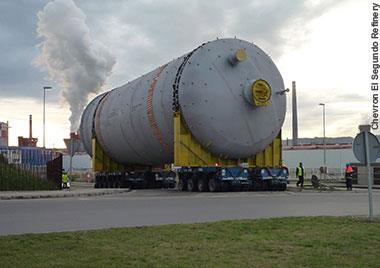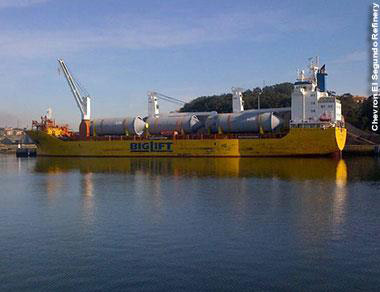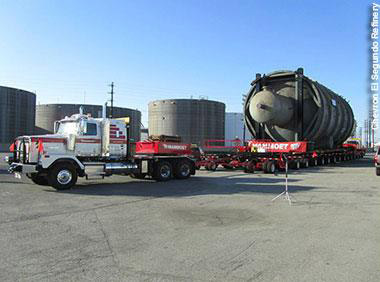CIVIL ENGINEERING | The Magazine of the American Society of Civil Engineers
By Catherine A. Cardno, Ph.D.
THE DRUMS WEIGH IN AT A WHOPPING 544,000 LB EACH, RESEMBLING CORN SILOS IN SHAPE. THEY WERE MOVED ALONG SURFACE STREETS USING SELF-PROPELLED MODULAR TRANSPORTS, OR SPMTS, SIMILAR TO THE ONE USED TO MOVE THE SPACE SHUTTLE ENDEAVOUR THROUGH THE CITY OF LOS ANGELES LAST YEAR. CHEVRON EL SEGUNDO REFINERY
 Six steel drums 100 ft long and 28 ft in diameter are being moved 4.5 mi from King Harbor to a Chevron refinery.
Six steel drums 100 ft long and 28 ft in diameter are being moved 4.5 mi from King Harbor to a Chevron refinery.
El Segundo. When you hear the name of this beachfront Southern California city (estimated population 16,775), bounded by Manhattan Beach and Los Angeles International Airport, you may very well think of an oil refinery. Even the translated name of the city—”The Second”—is a reference to its historical link to the local refinery, the second to be constructed in California by Standard Oil (now Chevron). More than 100 years old, the refinery today produces roughly 20 percent of the motor fuel used in Southern California and 40 percent of the jet fuel used at Los Angeles International Airport. With roots so deep and going back so far, it makes sense that equipment at the refinery that has reached the end of its service life is efficiently replaced. This is exactly what is happening to the refinery’s six enormous coke drums, which are 45 years old. Their replacements are being transported by barge from Los Angeles to nearby King Harbor, in Redondo Beach, and from there are being conveyed 4.5 mi overland to the Chevron El Segundo Refinery.
The steel-jacketed drums, which are 100 ft long and 28 ft in diameter and have walls 1½ in. thick, weigh in at a whopping 544,000 lb each and resemble corn silos. The drums recently arrived from Spain, where they were fabricated, and are now in the process of being moved along the California coastline according to a plan designed by Plump Engineering, Inc., of Anaheim, California, in conjunction with heavy-lift cargo transport experts, Mammoet, of the Netherlands.
The drums are being moved in pairs over three Wednesday nights. The first Wednesday was February 20, and the last will be March 6. The drums are the units in which coke, a by-product of oil refining, is deposited. Ultimately, the coke is fractured into smaller pieces with high-pressure water to create a cheap form of coal that is sold as fuel to China and Japan, according to Steve Wicklund, a project manager with Plump Engineering and one of the engineers who designed the plan for moving the drums.
The first phase transports the drums ¾ mi overland fr om King Harbor to an empty lot by means of self-propelled modular transports (SPMTs), explains Wicklund. Vehicles of this type have been shown on television, and they were used to move the space shuttle Endeavour through the streets of Los Angeles last year. The SPMTs are controlled by operators who walk alongside the cargo and use a wireless toggle switch to control the system within minute tolerances. Each wheel can be controlled independently, giving the system the ability to swivel and spin as necessary. When supersized cargo is being moved on SPMTs through very tight spaces, the SPMTs have the ability to turn on a dime, Wicklund says.
The SPMTs are not permitted to transport supersized goods on state highways, however, because their axle space is very narrow, concentrating the weight of the cargo on the highway's surface. Instead, the SPMTs are being used to transport the drums along streets from the harbor to jack stands located in an empty lot near the Pacific Coast Highway. There the SPMTs hydraulically lower themselves and drive out from beneath the drums.
From that location, a configuration involving 32 axles and a back foam beam for supporting the drums is used to move the load in the final stretch along the Pacific Coast Highway and Sepulveda Boulevard to the refinery. The beam and dolly system spreads the axle load over a greater area, Wicklund says. “So instead of having a four foot, eleven [inch] axle spacing, now you have a nine foot, one [inch] axle and the footprint of your weight is over a greater area.” A prime mover truck pulls the dolly, while a pusher truck brings up the rear.
THE SIX STEEL DRUMS RECENTLY ARRIVED AT THE PORT OF LOS ANGELES FROM SPAIN, WHERE THEY WERE FABRICATED. THERE ARE ONLY TWO LOCATIONS IN THE WORLD CAPABLE OF MAKING THE 100 FT LONG, 28 FT DIAMETER, 1 ½ IN. THICK STEEL JACKETED DRUMS. CHEVRON EL SEGUNDO REFINERY
Each of these transports measures 280 ft in length—a mere 20 ft shy of the length of a football field. Once mounted on the trailer, each drum reaches 34 ft into the air, or roughly the height of a three-story residence. Each dolly moves a single drum and is operated by six drivers, Wicklund says.
“When you calculate how you’re going to transport this and the amount of weight that you’re doing and the amount of axles that you have, you can actually take and reduce your loading footprint down to where it’s almost like a semitruck,” says Wicklund, “even though it’s much greater than that.” He adds that “of course, you’re traveling at a very slow rate of speed, so as a result the impact is pretty minimal to the roadway.” The journey proceeds at a leisurely walking pace, perhaps 2 mph, he notes.
The planning for the move required the engineers to examine everything in the path of the mammoth transport. Every bolt was turned to ensure traffic lights could be rotated out of the way, every overhead transmission line was examined, and every inch of pavement, including storm drains and sewers, was examined for strength and clearance, according to Wicklund. Four medians were removed to accommodate the transports’ turning radii, and they will be replaced once the move is complete, he says. Two locations with overgrown trees required trimming work so that the cargo would be able to make its way down the road.
In some locations at which power lines could not be lifted out of the way so that the transport could pass beneath, the power company developed alternative ways to deliver energy to the area. The lines in question could thus be de-energized and dropped into a tray so that the vehicles could move through; no customers have lost power, Wicklund says.
“The actual transport itself is probably one of the least-complicated portions of it, because once you start to roll, as long as everything is clear in front of you and you have a straight path, you’re basically rolling down the road,” Wicklund says. “I think the biggest challenge in all of this is to make sure that you’ve done all of your due diligence: to ensure that you evaluated everything that you know is out there in the substructure, that you accounted for every single overhead line, every overhead cable—everything that’s out there.”
 The coke drums will be lifted into their final location at the refinery next January. In the meantime, a crane considered to be one of the world’s largest—boasting a 400 ft boom and the capacity to move the 1 million lb derrick that sits atop the drums—will be transported to the refinery in pieces on approximately 200 trucks and assembled on-site to perform the task, according to Wicklund.
The coke drums will be lifted into their final location at the refinery next January. In the meantime, a crane considered to be one of the world’s largest—boasting a 400 ft boom and the capacity to move the 1 million lb derrick that sits atop the drums—will be transported to the refinery in pieces on approximately 200 trucks and assembled on-site to perform the task, according to Wicklund.
FOR THE LAST PORTION OF THE JOURNEY, THE DRUMS TRAVEL ON A DOLLY SYSTEM THAT DISTRIBUTES THE LOAD, SIMILAR TO A SEMITRUCK. THE SYSTEM TRAVELS APPROXIMATELY 2 MPH AND INCLUDES A TRUCK IN FRONT TO PULL THE LOAD AND ANOTHER IN BACK TO PUSH. CHEVRON EL SEGUNDO REFINERY
Testimonials
Hear from Plump Engineering's satisfied clients and discover how our engineering expertise brought their vision to life.